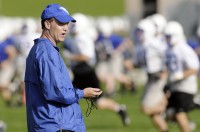We watch professional athletes and anyone who has made it to the top of their profession and they make it look easy. I was amazed to learn when I first read Malcom Gladwell’s book about the 10,000 hour rule.
Many coaches, parents, and athletes have heard at some point throughout their involvement in sport that 10 years and 10,000 hours of practice are required in order to become an elite athlete. The 10 year / 10,000 hour rule, as it has come to be known, is prominent in popular “talent” books such as Outliers, by Malcolm Gladwell, The Talent Code by Daniel Coyle, and Talent is Overrated by Geoff Colvin. It is also a popular topic of discussion at coach education workshops, and is identified as one of the 10 key factors influencing the Canadian Sport for Life Long Term Athlete Development framework.
Where did the 10 year / 10,000 hour rule come from and does it apply to sport?
In the first of a two part discussion, I will outline the origins of the 10 year / 10,000 hour rule, while Part 2 of the series will consider research investigating the 10 year / 10,000 hour rule in sport.
In 1973 the American Scientist published a research paper that would later become one of the most influential articles in cognitive psychology and the study of expertise (1). The research conducted by Herbert A. Simon and William G. Chase at Carnegie-Mellon University in the United States, was primarily focussed on the perceptual-cognitive processes associated with skilled performance in chess. Among a number of fascinating findings, Simon and Chase identified that:
“There appears not to be any case (including Bobby Fischer) where a person has reached grandmaster level with less than about a decade’s intense preoccupation with the game. We would estimate, very roughly, that a master has spent perhaps 10,000 to 50,000 hours staring at chess positions, and a Class A player 1,000 to 5,000 hours.”
And so the 10 year / 10,000 hour rule was born.
 In 1993, K. Anders Ericsson, Ralf Th. Krampe, and Clemens Tesch-Römer extended support for the 10 year / 10,000 hour rule into the musical domain (2). In what was to become another seminal research paper for the study of expertise, Ericsson and his colleagues asked violin players of four different skill levels to estimate the amount of time they had engaged in a variety of practice activities throughout the entire course of their involvement in music. The four groups of violin players included students at a leading music academy who were deemed by their teachers to be most likely to attain a career as an international soloist (“Best”), students at the same music academy deemed by their teachers to be likely to attain a career as a performer in an international orchestra but not as a soloist (“Good”), students training to become music teachers, not performers (“Teachers”), and a group of professional violin players (“Professionals”). By the age of 23, all participants in the research study had engaged in violin lessons for a period of 10 years or more. The graph below shows that at age 20, both the “Best” students and the “Professionals” had accumulated approximately 10,000 hours of practice over the duration of their careers, while the “Good” students and the “Teachers” had accumulated less than 8,000 hours and 5,000 hours respectively.
In 1993, K. Anders Ericsson, Ralf Th. Krampe, and Clemens Tesch-Römer extended support for the 10 year / 10,000 hour rule into the musical domain (2). In what was to become another seminal research paper for the study of expertise, Ericsson and his colleagues asked violin players of four different skill levels to estimate the amount of time they had engaged in a variety of practice activities throughout the entire course of their involvement in music. The four groups of violin players included students at a leading music academy who were deemed by their teachers to be most likely to attain a career as an international soloist (“Best”), students at the same music academy deemed by their teachers to be likely to attain a career as a performer in an international orchestra but not as a soloist (“Good”), students training to become music teachers, not performers (“Teachers”), and a group of professional violin players (“Professionals”). By the age of 23, all participants in the research study had engaged in violin lessons for a period of 10 years or more. The graph below shows that at age 20, both the “Best” students and the “Professionals” had accumulated approximately 10,000 hours of practice over the duration of their careers, while the “Good” students and the “Teachers” had accumulated less than 8,000 hours and 5,000 hours respectively.
To log your hours, coach tips on www.soccertoughness.com the service is free. No hidden costs.
Background information:
The website was created by Martha Castro RN not your typical soccer mom of four kids. She is a personal trainer and home schools her 4 kids. All her kids play soccer and states she lives on the “pitch”. Soccer slang for soccer field. She states she learned a lot over the years and decided to share her knowledge with other soccer parents, players and coaches.
She began to research different topics in soccer and decided to developed a new local soccer website that is focus on soccer topics for parents, soccer players and coaches.
